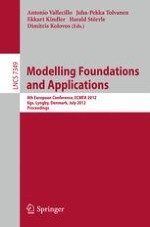This book constitutes the refereed proceedings of the 8th European Conference on Modelling Foundations and Applications, held in Kgs. Lyngby, Denmark, in July 2012.
The 20 revised full foundations track papers and 10 revised full applications track papers presented were carefully reviewed and selected from 81 submissions. Papers on all aspects of MDE were received, including topics such as architectural modelling and product lines, code generation, domain-specic modeling, metamodeling, model analysis and verication, model management, model transformation and simulation. The breadth of topics, as well as the high quality of the results presented in these accepted papers, demonstrate the maturity and vibrancy of the field.
